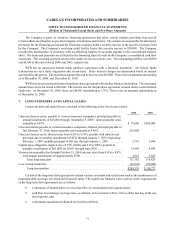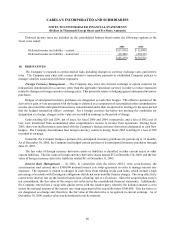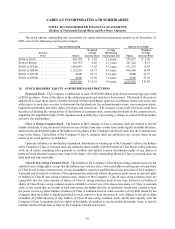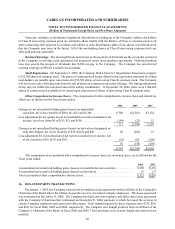Cabela's 2006 Annual Report Download - page 89
Download and view the complete annual report
Please find page 89 of the 2006 Cabela's annual report below. You can navigate through the pages in the report by either clicking on the pages listed below, or by using the keyword search tool below to find specific information within the annual report.
85
CABELA’S INCORPORATED AND SUBSIDIARIES
NOTES TO CONSOLIDATED FINANCIAL STATEMENTS
(Dollars in Thousands Except Share and Per Share Amounts)
The effect on the Company’s results of continuing operations for fiscal year 2006 of recording share-based
compensation, including ESPP shares, was to increase selling, general and administrative expenses by $3,615
and to reduce consolidated net income by $2,259 (or $.03 per basic and diluted share). There was no share-based
compensation capitalized in assets as of December 30, 2006.
As of December 30, 2006, the total unrecognized deferred share-based compensation balance for unvested
shares issued after becoming a public company, net of expected forfeitures, was approximately $5,369, net of tax,
which is expected to be amortized over a weighted average period of 4.5 years.
Prior to the adoption of FAS 123R, the Company presented all tax benefits resulting from the exercise of stock
options as operating cash inflows in the consolidated statements of cash flows, in accordance with the provisions
of the EITF Issue No. 00-15 Classification in the Statement of Cash Flows of the Income Tax Benefit Received
by a Company upon Exercise of a Nonqualified Employee Stock Option. FAS 123R requires the benefits of tax
deductions in excess of the compensation cost recognized for those options exercised to be classified as financing
cash inflows on a prospective basis. This amount is shown as “Excess tax benefit from exercise of stock options” on
the consolidated statement of cash flows. For fiscal year ended 2006, the excess tax benefit realized from exercised
stock options and similar awards was $495. The Company has elected to adopt the transition method described in
FSP FAS 123(R)-3, Transition Election Related to Accounting for the Tax Effect of Share-Based Payment Awards.
Pro forma Information:
Since the Company went public in 2004, all options granted prior to 2004 are accounted for in accordance with
APB Opinion No. 25. The Company’s calculations are based on a single option valuation approach and forfeitures
were recognized as they occurred. The fair value of these options was estimated at the date of grant using the
minimum value approach. The Company’s ESPP was deemed non-compensatory under the provisions of APB
Opinion No. 25. Stock-based compensation costs were reflected in consolidated net income where the options
granted under those plans had an exercise price that was less than the fair value of the underlying common stock
on the date of grant. The pro-forma stock based employee compensation expense for shares granted prior to being
a public Company was $247 net of tax for fiscal 2006. The pro forma information regarding net income, required
by FAS 123, as amended by FAS 148, Accounting for Stock-Based Compensation—Transition and Disclosure, is
presented in the following table and has been determined as if the Company had accounted for its employee stock
options under the fair value method by these standards. The pro forma information in periods prior to the adoption
of FAS 123R is as follows for the fiscal years ended:
2005 2004
Net income - as reported.............................................. $72,569 $64,996
Add: Stock based employee compensation recognized, net of tax . . . . . . . . . . . . . 600 1,086
Deduct: Pro-forma stock-based employee compensation expense
determined under fair value based method for all shares granted
as previously reported, net of tax. . . . . . . . . . . . . . . . . . . . . . . . . . . . . . . . . . . . . (6,811) (4,759)
Net income - pro forma . . . . . . . . . . . . . . . . . . . . . . . . . . . . . . . . . . . . . . . . . . . . . . . $66,358 $61,323
Earnings per share:
Basic - as reported ................................................ $ 1.12 $ 1.06
Basic – pro forma................................................. $ 1.03 $ 1.00
Diluted - as reported............................................... $ 1.10 $ 1.03
Diluted – pro forma ............................................... $ 0.97 $ 0.94
Valuation Assumptions:
The fair value of options granted on and subsequent to May 1, 2004, is estimated on the date of the grant using
the Black-Scholes option pricing model. Since the Company has only been public since June 2004, the volatility
factor was derived using a historical volatility model as well as comparisons to peers in the Company’s market
sector.
























